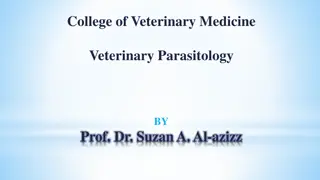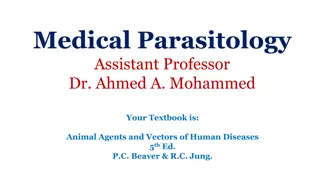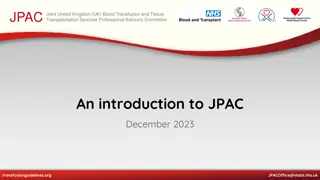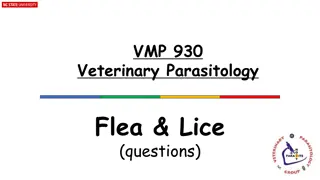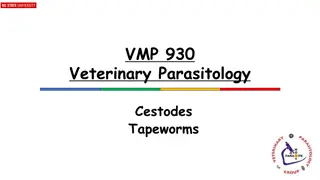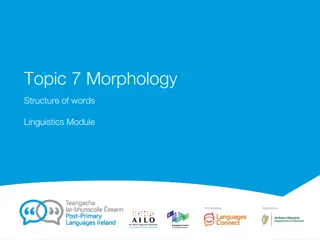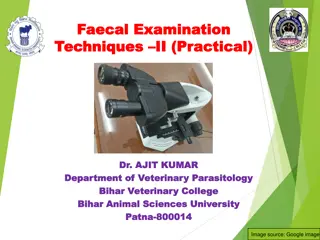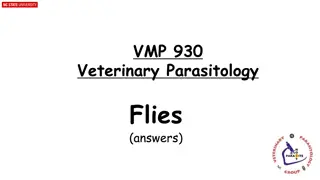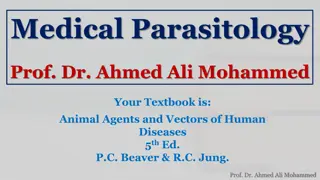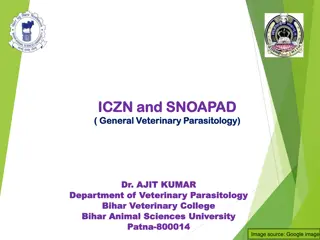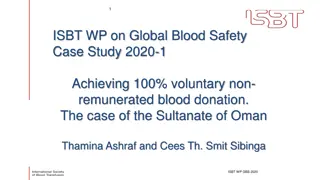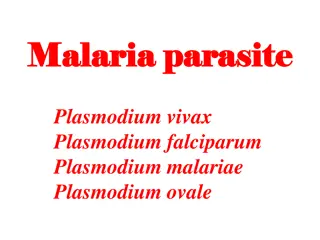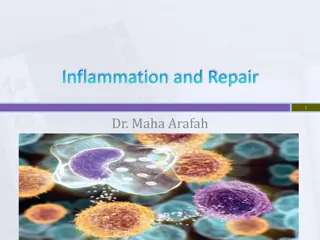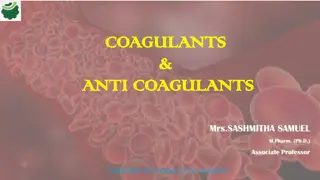Life Cycle and Morphology of Blood and Tissue Flagellates in Parasitology
Blood and tissue flagellates, such as Leishmania and Trypanosoma, have complex life cycles involving vertebrate and arthropod hosts. They go through various stages with distinct morphological features like promastigote, epimastigote, trypomastigote, and amastigote. Leishmania mainly infects mammals like humans and rodents, with sand flies serving as the vector in their transmission cycle.
Download Presentation

Please find below an Image/Link to download the presentation.
The content on the website is provided AS IS for your information and personal use only. It may not be sold, licensed, or shared on other websites without obtaining consent from the author. Download presentation by click this link. If you encounter any issues during the download, it is possible that the publisher has removed the file from their server.
E N D
Presentation Transcript
Medical Parasitology Assistant Prof. Dr. Ahmed A. Mohammed Lecture 4 Protozoa
B. Blood and tissue flagellates: All these organisms require two hosts in their life cycle, man or another susceptible mammal on the one hand and a blood sucking insect on the other hand. These flagellates related to genus Leishmania and Trypanosoma. They are passing through many stages in their life cycle which a distributed between the vertebrate host (the final host) and the arthropod host (the intermediate host). These stages are different in their morphology, flagellumposition and if it is found or not, the shape of the kinetoplast and its position and the presence or absence of the undulating membrane. They are summarized in the following:
1. Promastigote (leptomonad form) The body is spindle in shape, the nucleus in the middle of the body (relatively). The kinetoplast nearby the anterior end, the flagellum extends from this structure and continues toward the outside of the body; there is no undulating membrane.
2. Epimastigote (crithidial form) The body is spindle in shape, the kinetoplast in front of the nucleus which is found nearby the middle of the body, toward the posterior end. There is an undulating membrane, the flagellum grows and extend within the body till the anterior end through the undulating membrane then extends freely.
3. Trypomastigote (trypanosomal form) The body is spindle in shape, the nucleus in the middle of the body, the kinetoplast found in the posterior region of the body; it produces the flagellum which extends on the outer margin of the undulating membrane then extends freely.
4. Amastigote (leishmanial form) The body is spindle in shape, the nucleus in the middle of the body, the kinetoplast found in the posterior region of the body; it produces the flagellum which extends on the outer margin of the undulating membrane then extends freely.
I- Leishmania The vertebrate host is mammals, particularly the human, dogs and many species of rodents. The invertebrate host is sand fly (the vector). Life cycle: A. The Vertebrate host: When a sand fly holds the infective stage of Leishmania (the promastigote stage) takes a blood meal from man or other mammals, it will passively inject these parasites which will be picked up later by the reticuloendothelial system and transform to amastigote stage. It is passing through sequence binary fissions until cells are filled with the parasites and burst to release these parasites which may infect other cells.
At times, many infected phagocytic cells arrive to circulation and to viscera, where the parasite settles down and multiply in the reticuloendothelial cells of the liver, spleen and boon marrow, causing the destruction of these cells. B. The Invertebrate host: These are many species of sand fly from genus Phlebotomus. However, when the insect bites the infected vertebrate host, it will suck the blood and the parasite (amastigote stage) which migrate then to the midgut of the insect and transform to promastigote stage and start in multiplication by binary fission. The parasites may be sticks on the intestinal wall of the insect or stay free in the lumen of the intestine. It may be found in aggregations of promastigote stage in the first and last part of the gut.
After 4 to 5 days from the insect feeding, the promastigotes (the infective stage) will fill the esophagus and when they block the esophagus, the insect will push the esophagus contents to the front and back; by this method it will inject the infective stages in the victim.
The genus Leishmania includes the following species: 1. Leishmania donovani This parasite causes a disease called Kala-azar or Dum-Dum fever or visceral Leishmaniasis or black fever. Its vector is the sand fly (Phlebotomus papatasi). In the body of the vertebrate host, the parasite spreads in many parts, particularly, in the endothelial cells of the blood and lymph capillaries of the spleen, liver and bone marrow. Sometimes, the parasite infects the skin again and multiplies there. In this stage, the disease called dermalLeishmaniasis or post Kala-azar.
The incubation period varies from 10 days to many months, but in the usual case, it is insidious. On the average about 90 days following exposure. The symptoms can be observed are: 1. Great enlargement in the spleen and the liver with an increase in the size and number of parasitized Kupffer cells. 2. The bone marrow exhibits markedly increased production of macrophages and decreased erythropoietic function. 3. Thrombocytopenia results in multiple hemorrhages, particularly from the mucous membranes.
In the typical acute case: 1. Temperature fluctuates daily from 37.5 - 40 C. 2. Bleeding typically occurs from the gum, lips, naris and intestinal mucosa. 3. Complications usually observed in kala-azar are principally diarrhea or dysentery and broncho-pneumonia. Diagnosis It can be done by using serological methods (serodiagnosis) as well as the demonstration of the parasite itself microscopically in the biopsy specimens taken from the bone marrow, spleen, liver or blood sample. The parasite found inside the macrophages.
Treatment Pentavalent antimonial drug. The treatment should be given until the aspirate is free of parasites for at least (2) weeks. 2. Leishmania tropica This parasite causes a disease called dry or urban cutaneous Leishmaniasis or oriental sore or Baghdad boil or Old world cutaneous Leishmaniasis or tropica sore. The vector is Phlebotomus papatasi and Phlebotomus sergenti. The tissue reaction is initiated with the introduction of the promastigotes into the dermis. The macrophages in the vicinity picks up the parasites which rapidly transform to amastigotes and multiply, destroying the host cells. Soon after, there will be a dense concentration of macrophages in the invaded area, all of which are liable to infection and destruction. The lesion resulted from the insect bite become necrotic at the center, and the margins containing parasitized macrophages which may become infiltrated with giant and plasma cells.
Pathology and Symptoms The lesion appears in the beginning as a macula, then as a papule, with a slightly raised center covered by a thin blister like layer of epidermis. Then it breaks down, with discharge of a small amount of clear or purulent exudates. The incubation period many be as short as 2 weeks or as long as 3 years, but usually between 2-6 months. In uncomplicated cases there are no systemic manifestations. The common occurrence of phonic complications causes painful, disfiguring, local ulcer, neutrophilic leukocytosis and fever, and at times septicemia.
Diagnosis The uncomplicated lesion may be mistaken for a variety of infections of the skin; hence demonstration of the parasite is essential. Examination of Giemsa stained slides of the relevant tissue is still the technique most commonly used to detect the parasite. As well as the serological methods. Isolation of the organism in culture medium (using for example the diphasic NNN medium) or in experimental animals (hamsters) constitutes another method of parasitological confirmation of the diagnosis. Antibody detection can prove useful in visceral leishmaniasis but it is of limited value in cutaneous disease, where most patients do not develop a significant antibody response. Other diagnostic techniques including the isoenzymes, immunoassays and molecular approaches (PCR).
Treatment:Pentavalent antimonials. There is another type of this disease called muco-cutaneous Leishmaniasis or Espundia in Brazil or many other tropical parts in America. The infection clinically resembles the oriental sore, but it is caused byLeishmania braziliensis. The infection starts in the skin but the sores spread to extent regions and appear in a big number on the mucous membranes of the mouth, nasopharynx by extension or metastasis.It is also infecting the ear, nose cartilages and the throat, but not found in the blood and it is seldom in the inner viscera. The life cycle similar to that of L. tropica.




